#thimonnier
Photo

5 juillet 1857 : mort de Barthélemy Thimonnier, inventeur de la machine à coudre ➽ http://bit.ly/Barthelemy-Thimonnier Les broderies au crochet que les fabriques de Tarare, dans les montagnes du Lyonnais, faisaient exécuter dans les montagnes du Lyonnais et du Forez lui suggérèrent l’idée de construire une machine pouvant à la fois broder les étoffes et coudre les vêtements
#CeJourLà#5Juillet#Thimonnier#Inventeur#Machine#Coudre#Couture#Inventions#Broderie#Vêtements#Étoffes#Tissus#Biographie#histoire#france#history#passé#past#français#french#news#événement#newsfromthepast
8 notes
·
View notes
Photo

Machine à coudre ou à découdre est une expression qui fait référence à l’argot des poilus et qui signifie « mitraillette ». La mitraillette est une arme à répétition dégageant des coups secs et répétés de manière régulière, telle la machine à coudre.
Tu te goures fil à trous ! Ce n’est pas la machine à découdre ; c’est une motocyclette qui radine sur le chemin de l’abri.
- Henri Barbusse
#enseignes#thimonnier#machineacoudre#cliniquedelamachineacoudre#commercedisparu#vieillefrance#tracesdupasse#cantal
13 notes
·
View notes
Text


Employé avec une valeur d'adjectif qualificatif, le participe présent est nommé adjectif verbal. L'orthographe variant dans certains cas, il est important de les distinguer. Si par exemple le fait de mettre le mot au féminin ne “choque” pas, c'est qu'on se trouve en présence d'un adjectif (utilisé ici comme nom):
une blague d'une communi[k]ante
donc
une petite blague d'un communicant
Communicant qui a grenouillé* autour de plusieurs personnalités...
(En savoir plus sur la Banque de dépannage linguistique)
Rem. Les verbes en -quer qui forment un participe présent en -quant et un adjectif en -cant correspondent à un substantif en -cation.
Ex.: Communiquer/communication -> communiquant, communicant
Provoquer/provocation -> provoquant, provocant
Fabriquer/fabrication -> fabriquant, fabricant
mais Trafiquer/trafic -> trafiquant, trafiquant…
(Les verbes concernés sont communiquer, fabriquer, provoquer, suffoquer et vaquer, auxquels on peut ajouter convaincre). (cf. Thimonnier)
*grenouiller (Au fig., péj., surtout dans le domaine de la politique):
Participer à des intrigues, à des tractations malhonnêtes, le plus souvent pour obtenir des avantages.
0 notes
Text
How Has Sewing Machine Technology Evolved Over The Years?
Welcome to the world of sewing machines, where creativity and craftsmanship come together! Whether you're a seasoned seamstress or just starting your stitching journey, it's fascinating to take a look back at how sewing machine technology has evolved over the years. From humble beginnings to cutting-edge innovations, these marvelous machines have revolutionized the way we sew and create garments.
In this blog post, we'll dive into the captivating history of sewing machines, explore their early origins and advancements, delve into modern-day features that make sewing more efficient than ever before, discuss how these incredible devices have transformed over time, and even speculate on what lies ahead for future generations of sewing machine technology. So grab your thread spools and let's embark on this exciting journey through time!

The History of the Sewing Machine
The history of the sewing machine is a tapestry woven with innovation and ingenuity. The concept of mechanizing the process of stitching fabric traces back to ancient times, where various cultures developed rudimentary tools for sewing. However, it was not until the 18th century that significant advancements began to take shape.
In 1790, Thomas Saint, an English inventor, conceptualized the first working design for a sewing machine. Although his invention never made it into mass production, it laid the foundation for future pioneers in this field.
Fast forward to 1830 when French tailor Barthélemy Thimonnier created a functional sewing machine using a chain stitch mechanism. This breakthrough caught attention and sparked interest among inventors worldwide.
Soon after, American inventor Elias Howe patented his design for a lockstitch machine in 1846. This marked a turning point in sewing technology as Howe's invention featured essential components still used today: a needle with an eye at one end and a shuttle underneath to create interlocking stitches.
Isaac Singer then took center stage by introducing significant improvements to existing designs. His machines incorporated practical features such as foot treadles for hands-free operation and adjustable tension mechanisms.
As industrialization swept through the late 19th century, manufacturing companies like Singer and Brother emerged as industry leaders producing durable and efficient machines on large scales. The introduction of electric power further revolutionized sewing machines in the early 20th century, enhancing speed and precision.
Today's modern machines boast an impressive array of features catering to both professional seamstresses and beginners alike. From computerized controls offering countless stitch patterns to automatic threading systems that save time and frustration, these innovative marvels have truly democratized garment creation.
The history of the sewing machine showcases humanity's unwavering quest for progress within textile arts. Each iteration brought us closer to perfection – making our lives easier while amplifying our creative potential along the way.
Early Sewing Machines
The invention of the sewing machine revolutionized the way people created and repaired clothing. Early sewing machines, although crude by today's standards, laid the foundation for the modern wonders we have today.
One of the earliest known attempts at a mechanical sewing device was made in 1755 by Charles Frederick Wiesenthal. However, it wasn't until decades later that significant progress was made. In 1790, Thomas Saint patented a design that resembled a modern-day sewing machine. His creation had many features we still see today, such as an overhanging arm and a needle with an eye at one end.
Another key figure in early sewing machine development was Elias Howe. In 1846, he received a patent for his lockstitch mechanism which greatly improved stitching accuracy and durability. Howe's invention paved the way for countless advancements to come.
Isaac Singer is often credited with bringing affordable and practical sewing machines into households worldwide. He invented numerous improvements to existing designs including foot pedals for better control and tension discs to regulate thread tension.
These early innovations set the stage for future advancements in sewing technology. From mechanical machines powered by hand or foot to electric models that eliminated manual labor altogether, each iteration aimed to make sewing faster, more accurate, and easier for users of all skill levels.
Despite their simplicity compared to modern counterparts loaded with bells and whistles like computerized functions and automatic threading systems, these early machines were revolutionary in their own right.
The evolution of early sewing machines sparked a wave of interest from inventors who sought ways to improve upon them further. This led us down a path of continuous innovation where new technologies were integrated into every aspect of these handy devices.
As time went on, manufacturers introduced features such as zigzag stitching capability for decorative purposes or stretch fabrics' manipulation during World War II when elastic materials became scarce due to rationing efforts.
From thereon out came more advanced mechanisms like computerized controls that allow for precise stitch selection and customization. These technologies have made sewing accessible to beginners
Modern Sewing Machines
In today's fast-paced world, modern sewing machines have become a must-have for fashion enthusiasts and DIY lovers alike. These sleek and innovative machines have come a long way from their humble beginnings, incorporating cutting-edge technology to make sewing easier and more enjoyable than ever before.
One of the key advancements in modern sewing machines is computerization. Gone are the days of manually adjusting stitch length or tension; now, you can simply select your desired settings on a digital display panel and let the machine do all the work. This not only saves time but also ensures consistent and precise stitching every time.
Another remarkable feature of modern sewing machines is their versatility. With a wide range of built-in stitches and embroidery patterns, these machines allow users to unleash their creativity and bring their design ideas to life with ease. Whether you're making intricate quilts or crafting personalized garments, there's a stitch or pattern for every project.
Moreover, modern sewing machines are designed with user-friendliness in mind. Many models come equipped with automatic needle threading systems that eliminate the frustration of trying to thread tiny needles by hand. Additionally, features like speed control settings enable beginners to start at a comfortable pace while they hone their skills.
Furthermore, advanced technologies such as computerized sensors contribute to safer sewing experiences. These sensors can detect fabric thickness or even when the bobbin thread is running low, automatically adjusting settings accordingly to prevent jams or errors.
The introduction of portable and lightweight models has made it easier than ever for sewers on-the-go to tackle projects wherever inspiration strikes. Compact yet still packed with powerful features, these portable options offer convenience without compromising functionality.
As we continue into an era driven by innovation and technological advancement, it's exciting to imagine what lies ahead for sewing machine technology. With artificial intelligence becoming increasingly prevalent in various industries, we may soon witness smart sewing machines capable of analyzing fabrics and providing tailored recommendations for stitches or patterns based on individual projects.
Modern sewing machines have revolutionized the art of sewing
How Sewing Machines Have Evolved Over The Years
Sewing machines have come a long way since their humble beginnings. In the early days of sewing, people relied on hand stitching to create garments and other fabric items. It was a labor-intensive process that required skill and patience.
Then came the birth of the first mechanical sewing machine in the late 18th century. These early machines were operated by cranks and levers, making them more efficient than hand stitching but still limited in their capabilities.
Fast forward to the modern era, where we now have computerized sewing machines with advanced features like automatic needle threading, digital displays, and programmable stitch patterns. These machines are designed to make sewing easier and more accessible for beginners and experienced sewers alike.
But it's not just about convenience - sewing machine technology has also improved in terms of speed and precision. High-speed industrial machines can stitch up to thousands of stitches per minute, allowing for faster production times in industries such as fashion and textiles.
In addition to speed, modern sewing machines offer a wide range of stitch options that can be adjusted at the touch of a button. From basic straight stitches to intricate embroidery designs, these versatile machines give sewers endless creative possibilities.
Another significant advancement is the development of portable sewing machines. Compact and lightweight models allow users to take their projects on-the-go or easily store them when not in use.
Furthermore, innovations like automatic thread cutters and adjustable presser foot pressure have made sewing even more convenient and user-friendly.
As technology continues to evolve at an unprecedented rate, it's exciting to imagine what future advancements will bring to the world of sewing machine technology. Will we see even smarter automated features? Perhaps integration with smart devices or artificial intelligence-driven design suggestions?
The possibilities are endless! But one thing is certain: whether you're a beginner or an expert sewer, there has never been a better time than now to explore your creativity with today's state-of-the-art sewing machine technology
The Future of Sewing Machine Technology
As we look ahead to the future, it's clear that sewing machine technology is poised for even more exciting advancements. With the rapid pace of technological innovation, we can expect to see a range of improvements and new features that will revolutionize the way we sew.
One area where we may see significant progress is in connectivity. Imagine being able to control your sewing machine wirelessly from your smartphone or tablet, adjusting settings and accessing an endless array of patterns and designs with just a few taps on a screen.
Additionally, there could be advancements in automation and artificial intelligence. We might see machines that can automatically thread needles, adjust tension settings based on fabric type, or even suggest innovative design ideas based on current trends.
Furthermore, sustainability is likely to play an increasingly important role in future sewing machines. Manufacturers may focus on developing eco-friendly materials and energy-efficient mechanisms to reduce waste and minimize environmental impact.
In terms of user experience, intuitive interfaces and ergonomic designs are expected to become more prevalent. Sewing machines could incorporate touchscreens with user-friendly navigation systems, making them accessible for beginners while still offering advanced capabilities for experienced users.
Looking forward, it's also possible that 3D printing technology will have a place in the world of sewing machines. This could allow users to create their own custom attachments or accessories right at home without needing specialized tools or equipment.
While these possibilities represent a glimpse into what the future holds for sewing machine technology, one thing is certain: as our needs evolve and technology continues to advance at breakneck speed, so too will our beloved stitching companions adapt and transform alongside us.
Conclusion
As we have explored the history and evolution of sewing machine technology, it is clear that these versatile machines have come a long way. From their humble beginnings as simple hand-cranked devices to today's advanced computerized models, sewing machines continue to revolutionize the world of fashion and textiles.
The advancements in sewing machine technology have made it easier than ever for beginners to get started with this rewarding hobby. With user-friendly features like automatic threading, adjustable stitch lengths, and built-in tutorials, modern sewing machines are designed to make learning a breeze.
Not only do these machines offer convenience and efficiency, but they also open up endless possibilities for creativity. Whether you're interested in quilting, garment construction or home decor projects, there is a sewing machine out there that can meet your needs.
Looking ahead to the future of sewing machine technology, we can expect even more exciting developments on the horizon. As automation continues to play a significant role in our lives, it's likely that we will see further integration of smart features into sewing machines. Imagine being able to download patterns directly onto your machine or having it automatically adjust tension settings based on fabric type – the possibilities are truly endless!
In conclusion (without explicitly stating "in conclusion"), as new technologies emerge and consumer demands evolve, one thing remains certain: sewing machines will always be an essential tool for creative individuals looking to bring their ideas to life through fabric and thread. So whether you're a seasoned pro or just starting out on your stitching journey as a beginner sewist, embrace the power of modern sewing machine technology and let your imagination run wild! Happy stitching!
0 notes
Text
V I C T O R I A N E R A
The Victorian era was extremely impactful to Britain. As Britain gained enormous wealth and status as a world leader. Britain expanded its vast empire across the globe and underwent great developments in fields such as technology, industry, medicine, and science.
The sewing machine


-Thomas Saint first drew and described a sewing machine in 1290.
-In William newton Wilson found the drawings and was able to build a machine.
-In 1820 Barthelemy Thimonnier, a French tailor, invented the first successful sewing machine that used a hooked needle and one thread, creating a chain stitch.
-After the success Thimonnier created the worlds first machine based clothing manufacturing company. However other French tailors became jealous of thimonniers success and feared the machines would cause unemployment within the industry. This leading a group to burn down thimonniers factory with him still inside.
- In 1834 Walter Hunt created America’s first functioning sewing machine. However Hunt thought such a machine would cause unemployment for many, so he didn’t bother going through with the design.
-In 1844 John fisher an English inventor designed a sewing machine that would eliminate this disparity between the moving parts.
- In 1845 American Elias Howe invented a sewing machine that resembled fishers machine with some small adjustments “a process that uses thread from 2 different sources.” The needle went through the fabric creating a loop, a shuttle on a track that slipped the second thread through the loop, this creating what is called the lockstitch.
-Isaac Merritt Singer like many others had copied Elias Howe Isaac Merritt Singer is one of the most well-known sewing machine manufacturers in the world. He developed the first version of our modern day sewing machine, with a foot pedal and the up-and-down needle. Elements from the Howe, Hunt and Thimonnier inventions inspired Singer, causing Howe to file a lawsuit.
. (2019). Who Invented the Sewing Machine? History, Facts & Scandals Revealed. [Online]. contrado. Last Updated: 10 April 2019. Available at: https://www.contrado.co.uk/blog/history-of-the-sewing-machine/ [Accessed 21 January 2023].
0 notes
Text
The invention of the sewing machines:
The sewing machine was one of the most important technologies of the Victorian era, yet its origins date back to the 18th century. The first patent related to mechanical sewing was issued in 1755, after more than 20,000 years of manual stitching and over 300 years after the invention of the first eyed needles. Even though there were no plans for a machine to use the needle, Charles Weisenthal was granted a patent for it. In 1790, English inventor and cabinet builder Thomas Saint received the first patent for a full machine. However, subsequent attempts to build the machine from his ideas failed. This was followed in 1810 by the invention of an automated machine for stitching hats by Balthasar Krems. It never worked well, and he never patented it. In 1804 Thomas Stone and James Henderson received a French patent for 'a machine that replicated hand stitching.' Scott John Duncan got a patent for 'an embroidery machine with several needles' the same year. Both of these failed and were quickly forgotten. Another effort was made in 1814 by Austrian tailor Josef Madersperger, who received a patent for his work.
youtube

youtube
Barthelemy Thimonnier, a French tailor, produced the first working sewing machine. The machine only utilised one thread and was intended for embroidery. However, it was one of the first occasions when technical breakthroughs threatened jobs, and it was met with hostility by a group of French tailors. They were so outraged that they burnt down his clothing factory and fled for his life! Walter Hunt created the first fairly effective sewing machine in 1834, but he did not patent it because he, like the French tailors, believed the technology would generate unemployment. Elias Howe received the first American patent twelve years later for 'a technique that employed thread from two separate sources.' Around the same time, John Fisher constructed a lace-making machine that, like Hunt and Howe's, might be termed a sewing machine. However, his patent was misfiled, denying him the right to claim the invention of the sewing machine.

In the 1850s, Isaac Singer mass-produced the sewing machine for the first time. His sewing machine, unlike Hunt's and Howe's, employed an up-and-down motion to sew rather than a side-to-side motion. Singer did, however, utilise a lockstitch, as did Hunt and Howe's machines. Elias Howe successfully sued Isaac Singer for patent infringement since Walter Hunt never patented his mechanism.
0 notes
Photo

On this day, September 10, in 1846, the Massachusetts machinist and inventor Elias Howe, Jr. (1819-1867) was awarded U.S. Patent 4,750, the first United States patent for a sewing machine using a lockstitch design.
Others had proposed and even manufactured designs for mechanical sewing apparatus, beginning with a German immigrant to London, Charles Weisenthal, who, in 1755, patented a needle to be used in such a machine, though he proposed no machine with which to pair it. Others would soon follow, though their machines similarly were incomplete or suffered design faults that prevented them from working well enough to be put to practical use.
The French inventor Barthélemy Thimonnier invented a machine that was patented by the French government in 1830, and within ten years was operating a factory with 80 machines sewing uniforms for the French army. But Thimonnier’s factory was destroyed by Parisian tailors who feared that his machines would put them out of work. Despite repeated efforts and new patents for improvements to his machine in 1841, 1845, and 1847, which received prizes and acclaim when exhibited at the 1855 World Fair in Paris, Thimonnier’s invention was a commercial failure, and he died a poor man in 1857.
Howe’s invention almost met the same fate, as he struggled to find financial backers to assist in the production of his machine. As he persevered with little luck in turning his invention into a commercial product, other more financially savvy entrepreneurs began manufacturing machines using his design. Most famously, Howe was forced to pursue a court case against Isaac Singer and Walter Hunt from 1849 to 1854, as the two men had begun selling a machine based on his patent. Howe eventually won the dispute. Much of the settlement and royalties he earned as a result went toward providing equipment for the 17th Connecticut Volunteer Infantry of the Union Army during the Civil War, a unit in which he also served as a private. But the funds also allowed him to establish The Howe Machine Co. in Bridgeport, Connecticut around 1866. Both Elias Howe Jr. and Isaac Singer died wealthy men.
The sewing machine in this July, 1943 advertisement was created nearly 100 years after Howe’s patent was granted. Industrial designer Peter Muller Munk’s (1907–1967) contribution to the design was the replacement of the traditional metal sewing machine shell with Durez plastic, which he proposed would not only reduce the weight of the machine, but would also offer options for color finishes that would appeal to consumers.
The item is part of the Hagley Library’s John Okolowicz collection of publications and advertising on radio and consumer electronics (Accession 2014.277). To view it online, alongside other material from this collection, click here to visit its page in our Digital Archive.
#otd#on this day#on this date#sewing machine#history of invention#Elias Howe Jr.#Barthélemy Thimonnier#Isaac Singer#patent law#patent history#U.S. Patent Office#Howe Machine Co.#1940s#plastic#sewing#sewing machines#vintage sewing machine#Peter Muller Munk#Durez Plastic & Chemicals#North Tonawanda NY#New York history#Sewing Machine Day#National Sewing Machine Day#sewingmachineday
26 notes
·
View notes
Text
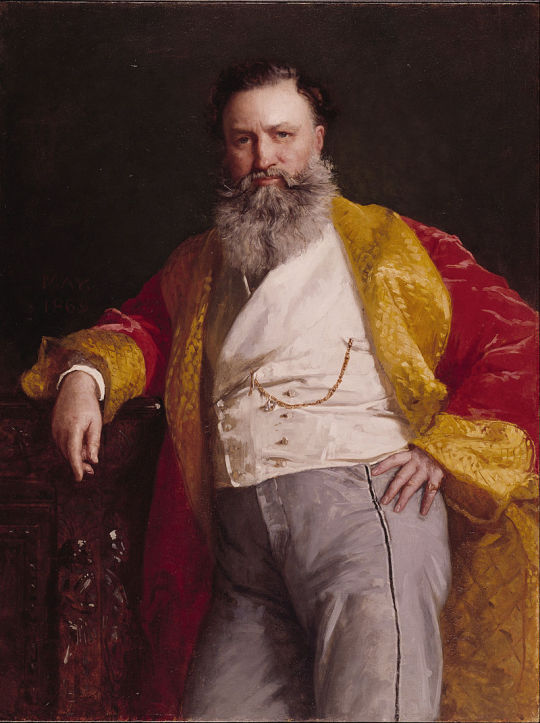
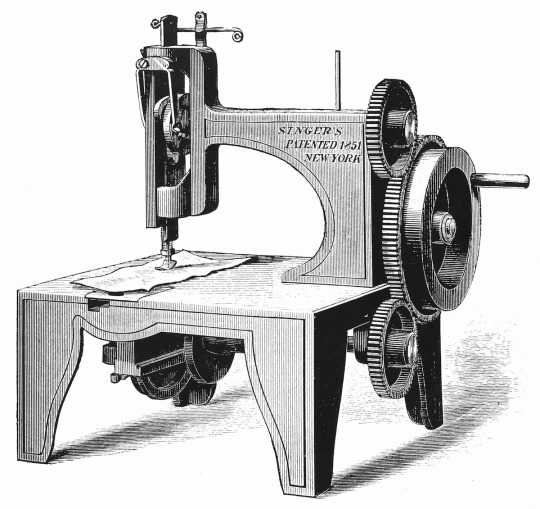
Issac Singer didn't invent the sewing machine, but he did invent the first commercially successful sewing machine. The earliest sewing machine-like device was invented by Berthelemy Thimonnier in 1830, and was used to mass manufacture uniforms for the French army. It could sew quickly, but it was only capable of making a basic chain stitch that unravelled easily. It was powered by a hand crank and the needle moved side to side. In 1831, 200 tailors rioted, destroying his machinery and burning his factory. Others made their own versions of the device, improving the technology as they went along. American Walter Hunt was so afraid of creating mass unemployment among seamstresses with his device that he didn't seek a patent.
Eventually, in 1846, Elias Howe patented the first practical sewing machine, having worked on it obsessively for years, costing him his health and keeping his family in debt. His finished machine was capable of 250 stitches per minute, compared to the typical 40 stitches a minute that could be done by hand. However, the machine cost $300, making it prohibitively expensive for anything that wasn't at an industrial scale.
Then Isaac Singer came in with a needle that was powered by a foot treadle and went up and down instead of sideways. Howe, meanwhile, lost his American workshop in a fire and got swindled out of his British royalties. He had to sell his father's farm to make up the money to sue Singer. After years of struggle, a judge finally sided in his favor. Eventually, Howe and Singer pooled their patent, and Howe was finally making a decent amount of money off of the invention that had cost him so much.
But Singer's name was the one that would become synonymous with sewing machines, because he was the one who mass manufactured a sewing machine that was affordable by the average housewife. Singer was eventually able to expand into the European market, becoming one of the first American multinational companies.
171 notes
·
View notes
Text
5 Facts You Might Not Know About Sewing

Women's garment buttons are sewn on the left side whereas men's garment buttons are sewn on the right side. If you just ran to your closet to check, you are in good company. This standard was established when buttons were expensive enough that only wealthy women could afford them. Since wealthy ladies of the time often had help getting dressed, the buttons were sewn onto the opposite side of the women's garments to make buttoning easier on the lady's maids.
We have found ancient remnants of cotton weaved material at archeological sites. In 2016, archeologists found the world's oldest known remnants of indigo-dyed cotton at a dig site in Huaca Prieta in northern Peru. How old was this cotton believed to be? An international team of archeologists analyzed 8 fragments and found that these fragments, likely from bags, were at least 6,000 years old. To top it off, the pattern of blue-indigo dye and ochre was still visible in some of the pieces. Now that is quality craftsmanship!
The tailor who patented the first mechanical sewing machine in France had his factory destroyed by other tailors twice. In 1830, Barthelemy Thimonnier patented a mechanical sewing machine that used a hooked needle to produce a chain stitch. This invention actually helped Thimonnier win a contract to make uniforms for the French Army! However, local tailors, angry and fearing the loss of their livelihood, banned together in a large mob and destroyed all 80 of the machines in his factory. Even though he barely escaped, Thimonnier got back on the horse and rebuilt the factory with even better machines. This time the mob did their angry mob thing again, but missed one machine that Thimonnier took with him to England. Thimonnier tried to start again in England, but was never successful. He ultimately died pennyless in 1857.
Rumor has it that the sewing machine company Singer ordered a buyback program for the original cast iron sewing machines in order to destroy them. The original cast iron Singer machines were said to be of such high quality that they could be passed down from generation to generation. That is good for the customer, but not the company's long term bottom-line. So it is rumored the company briefly tried to buyback machines that they would then smash with a sledgehammer. By the way, Singer was also the first company to offer installment payments if you could not afford to pay for the machine all at once. Thus, the company was able to sell two million sewing machines between 1853 and 1876.
Zippers weren't originally used for clothes! In 1851, the inventor of the sewing machine, Elias Howe, patented an "automatic, continuous clothing closure," but he didn't do anything with it as he was too busy promoting his sewing machine. 40 years later at the 1893 World's Fair, Whitcomb Judson debuted an updated version of the zipper that he called "clasp locker" as a fastener for shoes. However, he didn't have much success. In 1913, Gideon Sundback designed a "separable fastener" that would evolve into what we know as the modern zipper.
2 notes
·
View notes
Text
From a Smithsonian article on the invention of the sewing machine:
Walter Hunt was a prolific inventor and was described by Smithsonian curator Grace Rogers Cooper in her 1968 paper, The Invention of the Sewing Machine, as a “Yankee mechanical genius.” He designed a nail-making machine, a plow, a bullet, a bicycle and the safety pin, which was designed in three hours to settle a $15 debt. A clever man who was attuned to the tenor of the times, Hunt understood the value of a machine that could sew and set out to built one in 1832. He designed a simple machine that used two needles, one with an eye in its point, to produce a straight “lock stitch” seam and encouraged his daughter to open a business producing corsets. But Hunt had second thoughts. He was dismayed by the prospect that his invention might put seamstresses and tailors out of work, so he abandoned his machine in 1838 having never filed for a patent. But that same year, a poor tailor’s apprentice in Boston named Elias Howe began working a very similar idea.
After failing to build a machine that reproduced his wife’s hand motions, Howe scrapped the design and started again; this time, he inadvertently invented a hand-cranked machine almost identical to Hunt’s. He earned a patent for his design in 1846 and staged a man-vs-machine challenge, beating five seamstresses with work that was faster and in every way superior. Yet the machine was still seen as somewhat scandalous, and Howe failed to attract any buyers or investors. Undeterred, he continued to improve his machine.
A series of unfortunate business decisions, treacherous partners, and a trip oversees left Howe destitute in London. What’s more, his wife’s health was failing and he had no means to get back to her in America. He was very close to suffering the same fate that befell Thimonnier, becoming just another dead inventor in the poorhouse. After pawning his machines and patent papers to pay for steerage back to the States in 1849, the distraught Howe returned to his wife just in time to stand by her bedside as she died. Adding insult to injury, he learned that the sewing machine had proliferated in his absence – some designs were almost copies of his original invention while others were based on ideas he patented in 1846. Howe had received no royalties for any of the machines- royalties that likely could have saved his wife’s life. Destitute and alone, he pursued his infringers fiercely, with the single-minded dedication of a bitter man with nothing left to lose. Many paid him his due immediately but others fought Howe in court. He won every single case.
Soon after the conclusion of his last court case, Howe was approached with a unique offer. An machinist by the name of Isaac Singer had invented his own sewing machine that was different in almost every way than Howe’s; every way except one – its eye-pointed needle. That little needle cost Singer thousands of dollars in royalties, all paid to Howe, but inspired the country’s first patent pool. Singer gathered together seven manufactures –all of whom had likely lost to Howe in court– to share their patents. They needed Howe’s patents as well and agreed to all his terms: every single manufacturer in the United States would pay Howe $25 for every machine sold. Eventually, the royalty was reduced to $5 but it was still enough to ensure that by the time Elias Howe died in 1867, he was a very, very rich man, having earned millions from patent rights and royalties. Singer didn’t do too bad for himself either. He had a penchant for promotion and, according to American Science and Invention earned the dubious recognition of becoming the first man to spend more than $1 million dollars a year on advertising. It worked though. The world hardly remembers Elias Howe, Walter Hunt, Barthélemy Thimonnier, Josef Madersperger, and Thomas Saint, but Singer is practically synonymous with sewing machine.
Bold and colored emphasis mine.
#it’s a really interesting bit of history#both older and newer than you might think#pancake talks textiles#sort of
6 notes
·
View notes
Photo

5 juillet 1857 : mort de Barthélemy Thimonnier, inventeur de la machine à coudre ➽ http://bit.ly/Barthelemy-Thimonnier Les broderies au crochet que les fabriques de Tarare, dans les montagnes du Lyonnais, faisaient exécuter dans les montagnes du Lyonnais et du Forez lui suggérèrent l’idée de construire une machine pouvant à la fois broder les étoffes et coudre les vêtements
#CeJourLà#5Juillet#Thimonnier#Inventeur#Machine#Coudre#Couture#Inventions#Broderie#Vêtements#Étoffes#Tissus#Biographie#histoire#france#history#passé#past#français#french#news#événement#newsfromthepast
7 notes
·
View notes
Text
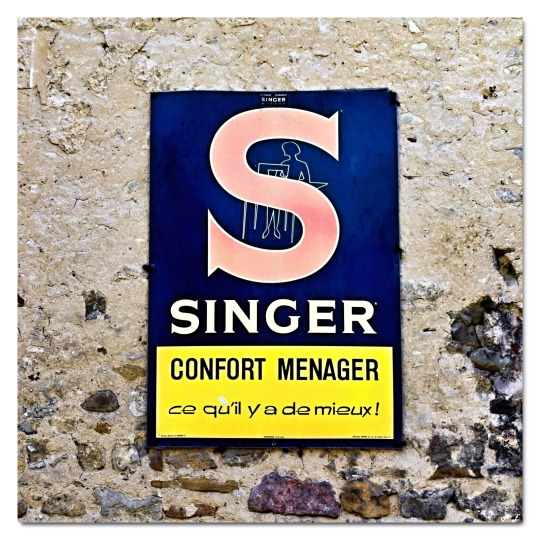
En minuscule en haut de la plaque on lit : “Affichage permanent Singer, de janvier 1970 à décembre 1979”. La Singer Sewing Machine Company est fondée à New-York, en 1851, par Isaac Merritt Singer suite aux améliorations importantes qu’il apporte aux machines à écrire et aux machines à coudre inventées par Barthélemy Thimonnier (qui meurt dans la misère en 1857.) En 1906, le quartier général de la société se trouve au Singer Building, conçu par l'architecte Ernest Flagg. La tour Singer était à l'époque la plus grande tour du monde. Sa démolition, en 1967, est intervenue en même temps que celles de deux autres monuments historiques : Penn Station et l'hôtel Waldorf-Astoria, à la veille de l'expiration du délai de soixante-dix ans d'ancienneté qui aurait permis de les protéger. Cette perte patrimoniale est aujourd'hui considérée comme irréparable par les historiens de la ville. L'usine Singer de Clydebank construite en Écosse en 1885 devient au début du 20e siècle la plus importante usine de machines à coudre au monde. Après la Seconde Guerre mondiale, les machines à coudre Singer ne dominent plus le marché mondial. Elles sont d'abord concurrencées par les produits de firmes allemande (Pfaff), suisse (Elna) et italienne (Vigorelli). Puis arrivent les machines à coudre japonaises vendues à des prix particulièrement compétitifs. Singer tente de résister en lançant en 1954 de nouveaux modèles plus légers, techniquement avancés et aux couleurs attrayantes. En 1989 l’entreprise est rachetée par la firme chinoise Grande Holdings Ltd qui s'offre également Pfaff en 1997. En 1999 Singer est mise en liquidation judiciaire à New York. Aujourd’hui, Singer fait partie du groupe SVP Worldwide qui possède également les marques Pfaff et Husqvarna Viking depuis février 2006.
4 notes
·
View notes
Text
What things to Look for in a New Sewing Machine
In the event that you talk to anybody who sews, they enables you to realize that the sewing machine is an ideal effective innovation of the last 200 decades, by far. It allows you to make your own personal apparel, bedding, quilts and decorative objects quickly and skillfully. It generates quick function of stitching items of substance together. With the advancements and development to the sewing machine over time, it has taken on a new dimension in crafting.
The thing that was after an excellent time preserving gadget for the ladies of yesteryear for sewing and sewing, the machine is now capable of complex, remarkably colored embroidery, also many other creative tasks and is just a wonderful time saver in comparison to performing any of these projects by hand. The number of choices are limitless with the developments and computerization of the fun sewing machines sewing machines .
Since each person has their very own ideas and wants because of their sewing jobs and projects, there's not the overall "perfect machine " for all. Do you embroider? If not you don't require this option on your own machine. Embroidery models can perform some fantastic work, but may also be expensive and this method will be useless for you if you're perhaps not planning on doing embroidery.
You will need to take the time to do a emotional catalog or with pen and paper create out which kind of tasks you are thinking about performing, maybe you've a favorite TV sewing show you view and you desire to create those projects, what types of sewing do they do? Do you want to be sewing numerous layers of fabric, leather, or other resources? Sewing on keys, performing quilting sections, performing quilts, sewing carpets, reupholstering, etc., etc. By creating an inventory you may have an excellent notion of the sewing machine which will most useful suite you.
Are you currently new to sewing ? Are you experiencing buddies or does your mom or grandmother sew ? Great, question them should they will reveal about their machine and their likes and dislikes of these machine. Does it do everything they want it to complete or are there improvements they wish they had. Frequently some one that is common with their machine will be ready to share with you if they like their machine , or if I just realized I could have get a different machine or I would 've got usually the one with such and such addition that this machine does not need and it can not be included to. Bring your list with you. Would a machine like mom's or grandma's fit your needs, how about your pals? This is a long-lasting relationship, therefore take your time and choose correctly, you will be pleased if you do.
Ahead of the creation of the sewing machine , all clothing, home furnishings and also agricultural sacks were made by hand. The group of activities and inventions that generated what we recognise today as a sewing machine were a very important section of history. Here's an breakdown of some the inventors, their contributions and exactly how we finally produced truth the desire of a machine that could take the labour out of sewing.
The initial individual to use for a patent for a sewing machine was a English founder named Thomas Saint in 1791, nevertheless his machine wasn't identified to possess ever been developed. The first real functioning sewing machine to be shown as such to the world was in 1814 by an Austrian target Josef Madersperger, even though number apparently working machine is considered to attended from his work.
In 1830 Barthlemy Thimonnier from France patented a functional machine that has been capable of sewing right seams with a sequence stitch. By 1841 he'd a factory of those products but it absolutely was allegedly sabotaged and burnt down by French tailors, they certainly were described to own seen the existence of the machines as a threat to their careers as opposed to the priceless function software that the sewing machine came to be. Thimonnier ultimately stumbled on Britain with a machine and was obviously the very first person to provide working devices on the market, he also ran a dress factory.
An National Walter Hunt developed the initial lockstitch sewing machine in 1833. This machine used 2 spools of bond by having an attention directed needle just like products of today, nevertheless the machine needed resetting too often to be viable. Yet another American, John Greenough, made a functional machine in which the needle transferred completely through the material but was struggling to generate enough interest to produce the machine for resale.
Elias Howe created a machine similar compared to that made by Walt Search in 1845. There have been several improvements which built his machine the most sensible however although he struggled to achieve financial backing. Following attempting to market his machine in England he go back to the US to locate lots of people had taken his thought and providing related models that apparently infringed his patent.
Isaac Merritt Artist was an engineer who made a decision to overhaul the circular sewing machine. His machine used a traveling taxi rather than a rotary one; the hook was installed vertically and involved a presser foot to put on the cloth in place. It'd a fixed supply to put on the hook and also involved a basic tensioning system. Singer got an National patent for his machine in 1851, he created a base pedal or treadle, for use along with his machines. Howe needed Performer and a few the others to court over patent breaches and was awarded some compensation.
An interesting fact, if you find these specific things fascinating, is that the initial hire-purchase type payment system is noted to own first been brought about by Performer and a attorney called Edward Clark, and was caused in order to allow visitors to afford to buy their sewing machines. The success of the Performer sewing machines tends to be credited more to the revenue techniques utilized by Singer and Clark, as opposed to such a thing outstandingly various with their machines.
Through the years other people and unions produced changes and manufactured more machines. There were higher than a several squabbles over patents and threats to sue. Allen N Wilson and Nathaniel Wheeler developed a calmer simpler machine underneath the Wheeler and Wilson Organization manufacturing products in the 1850s and 60s. As more individuals entered the style and production of sewing machines'The Sewing Machine War'came to exist as everyone attempted to guard their own rational house, ultimately Performer, Howe, Wheeler and Wilson and Grove and Baker got together with their patents building'The Sewing Machine Mix'in 1856. This pushed the other manufacturers to do points their way and spend a certificate cost for the privilege.
Knitting devices were first observed in 1877 in the shape of a crochet machine , this was created by a Joseph Merrow. This machine was in reality the first'overlock' sewing machine and The Merrow Machine Business however make overlock devices today.
In 1885 Singer patented the'Artist Vibrating Shuttle' sewing machine applying Allen T Wilson vibrating shuttle, this machine was more conform at lockstitching, exchanging the oscillating shuttles and continuing use till the circular shuttle products changed them.
1 note
·
View note
Photo
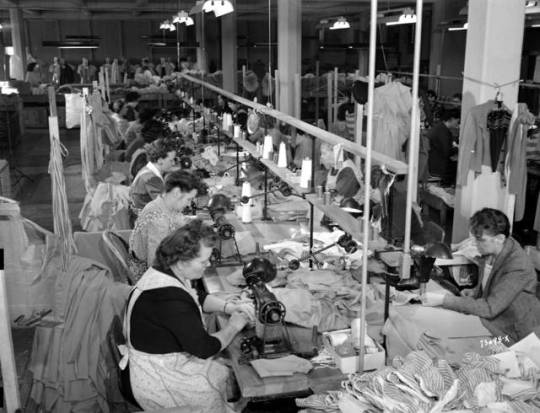
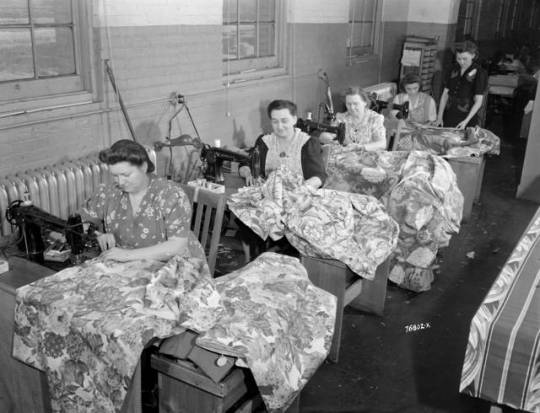
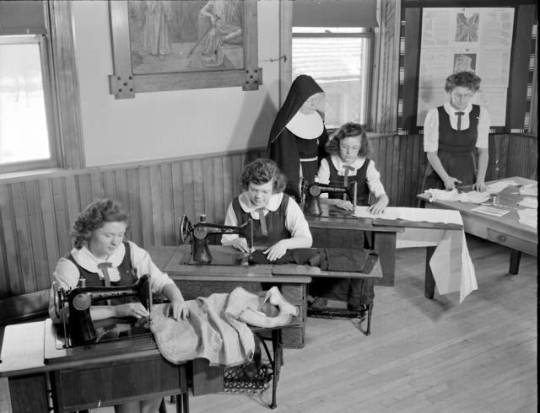
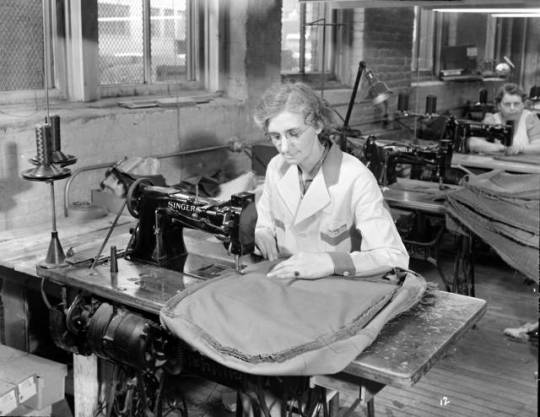
June 13th is Sewing Machine Day!
Sewing machines revolutionized not only sewing but consumerism more broadly. Generally considered to have been first invented in 1790 by Thomas Saint, the design of the first sewing machines developed over the course of the early 19th century before the first practical and widely used machine was created by Barthélemy Thimonnier in 1829 (patented in 1830).
Sewing machines cut production times by a huge margin, opening up time for leisure as women’s role in household management decreased. The burden of clothing production moved to factories, leading to an initially negative side effect of the invention, by taking many jobs from seamstresses. However, the positives of the sewing machine and industrial production quickly outweighed the negatives. Factories were able to employ many men, women, and children, which, when combined with the faster production times, meant an increased supply of clothing and other sewn goods, decreasing the overall cost of materials. Factories were able to produce more than just clothing, expanding into household goods, flooding the ever-growing market with greater variety. People went from having only one or two sets of weekday or work clothes and their Sunday best, to a larger wardrobe for a fraction of the cost.
The above photos come from the James Blair Murdoch Photo Collection (UWM Mss 131). The collection consists of approximately 2600 photos, both negatives and prints, primarily taken by Murdoch. Many of the photos are related to area businesses, such as advertising and insurance agencies, department stores, manufacturing industries, and service stations. The collection can be viewed in person in the Archives or online through our Digital Collections.
These photos date from the 1940s and capture a variety of individuals using sewing machines. The first photo shows women sewing in a factory; Murdoch’s notes associated with the photo indicate that the women worked in the Mayer Building in Milwaukee’s Third Ward. The second photo depicts women sewing items in the Boston Store. The third photo is less industrial, depicting three girls sewing while being supervised by a nun. In the background, there is a poster hanging on the wall that gives instructions related to different sewing techniques like darts and other finishes. The final photo shows a woman sewing an upholstery cushion, demonstrating the kind of household materials that could be made with the sewing machine.
This Sewing Machine Day, take a look at your wardrobe or around your house and think about how much work might have been required to sew everything by hand. Maybe take the opportunity to give sewing a shot – whether by hand or by machine. It’s a useful skill to have, and fun too. Check out the James Blair Murdoch Photo digital collection to see more photographs related to Milwaukee’s businesses and industries.
-Samantha Dickson, Archives Graduate Intern
#uwm archives#sewing#sewing machine day#sewing machine#James Blair Murdoch#digital collections#1940s#clothing#sewing history#milwaukee businesses#Milwaukee#milwaukee history#archives#women at work
17 notes
·
View notes
Text

Embarquement immédiat au Parc des Maraiches quartier du Perray à Nantes où un spectacle de haute tenue se profile à l’horizon ce mardi 26 juillet. "En attendant", c’est le nom de la proposition artistique présentée aux enfants et aux familles, s’inscrit dans la programmation du jour, la dernière de l’été dans le parc à l’initiative du Centre socioculturel du Perray et de la ludothèque de la Bottière.


Un toboggan géant à dompter, une chasse aux dinosaures improvisée, une potion magique pour endormir les princesses… les activités ludiques s’enchaînent à la vitesse de l’éclair. Lune et Agathe, animatrices Multispot au centre de loisirs du Perray l’attestent : cet été, les enfants ont une énergie décuplée. Libérés, enthousiastes de ne plus avoir à porter le masque, ils sont en demande de sorties en tout genre. De préférence en plein air. Une dynamique confirmée par les mamans et la médiatrice de quartier.


"Jules !!! Je n’ai pas le temps d’attendre comme ça… avec le réchauffement climatique ! Et cette chaleur, j’étouffe moi, mince ! Juleeeeeeessssssssss !!! Crotte de bique …". Le spectacle a commencé, les enfants hilares commentent les envolées du personnage campé par Zoé Thimonnier-Skriabin, comédienne et metteure en scène pour la Compagnie Nervous Breakdown. A ses cotés, Morgan, musicien, clarinettiste, enrichi la création, une sortie de résidence imaginée puis répétée en cinq jours avec "Ouvrir l'horizon", un collectif d'artistes créé pour défendre le spectacle vivant par vents et marées. Hassina et Nadia ont pris part au spectacle. Installées dans les transats, ces habitantes du Perray prennent le temps de s'évader aussi.

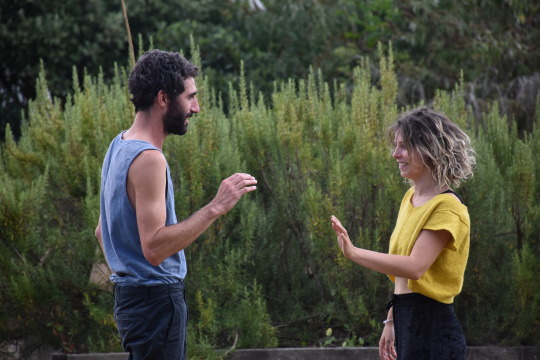
La création d'"une petite forme" pensée en sept scénettes raconte l’attente sous toutes ses formes, autant d’approches détournées pour apprivoiser au passage sa solitude. "Aérien, poétique, surprenant aussi !!!", Clément animateur ados au CSC Perray approuve. Le public, captif en redemande. "Elle fait des galipettes, se tape la poitrine, elle fait n’importe quoi !!!" relève Lubna. C’est vrai et c’est rigolo.

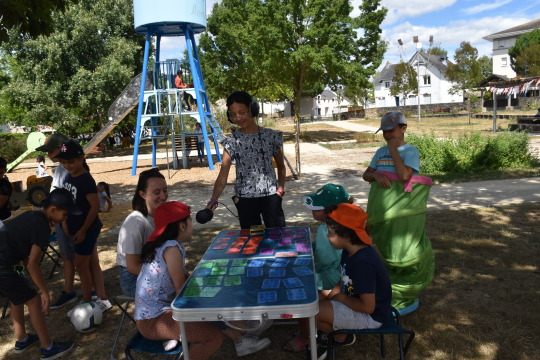
0 notes
Text
Le « silence « de la campagne électorale s’applique à tous
TOUT LE MONDE EST CONCERNÉ
Il est nterdit de distribuer des tracts, tenir des réunions publiques ou même commenter et diffuser des sondages ou des résultats le temps du week-end précédent le premier tour de l’élection.
La période de réserve électorale s’applique-t-elle aussi aux particuliers ?
par Marie Thimonnier le 9 avril 2022 Libération
Question posée le 8 avril
Bonjour,
Vous nous…
View On WordPress
0 notes